#200 films of 1952 film 55
Explore tagged Tumblr posts
Text

Day 56- Film: The Crimson Pirate
Release date: August 27th, 1952.
Studio: Warner Bros.
Genre: Adventure comedy
Director: Robert Siodmak
Producer: Norman Deming, Harold Hecht, Burt Lancaster
Actors: Burt Lancaster, Nick Cravat, Eva Bartok, Leslie Bradley, Torin Thatcher
Plot Summary: In the late 1700s, the pirate Vallo and his crew get caught up in a revolution happening on a fictional Caribbean Island. They try to rescue the lead rebel “El Libre” and his daughter Consuela, bringing them to safety while fighting enemies on all sides.
My Rating (out of five stars): *** ½
If you want to see a movie that is a non-stop barrage of tricks, action, and hijinks, absolutely look no further! This has more athleticism in it than most sports movies, and it never slows down. That alone makes it worth watching.
The Good:
The pure athleticism on display. It’s very entertaining to watch athletes having fun doing stunts and tricks, and that’s basically what this movie is all about. Watching Vallo and Ojo fly though the air, swinging and jumping and running all over, was a lot of fun.
Not only do we get lots of stunts and tricks and hijinks, but it’s nearly non-stop. Every time you catch your breath, it all starts up again.
The ships looked great. I’m laughably far from being any kind of expert on the subject, but they looked really cool to me.
The score. It was gorgeous.
The science in it! It was clearly spelled out at the end that the science and technology of the day would give the good guys the edge over the bad guys.
The scientist guy himself. I loved the character of Professor Prudence.
The comradery between Vallo and Ojo. Lancaster and Cravat had a long history of working together, and it shows. I loved watching them together.
I liked that it was a comedy just as much as it was an action or adventure film. It made it much more enjoyable and gave it even more energy.
Burt Lancaster in tight colonial era pants.
The Bad:
The romance. I just didn’t really buy the romance between Vallo and Consuelo. It felt either shoved in or tacked on, take your pick.
Consuelo as a character, and the way women were portrayed in general. Women in this movie are definitely the “damsels in distress” type. And the “object to be won” type. They don’t have much agency or any kind of fleshed-out characteristics.
Lancaster’s blonde hair. Why?
It moved so rapidly sometimes it was hard to keep track of what was happening. It took me awhile to really get into the story and fully find my bearings. Sometimes that worked just because the action was fun, but sometimes it could be frustrating.
#project1952#1952#project1952 day 56#100 films of 1952#burt lancaster#200 films of 1952#200 films of 1952 film 55
0 notes
Text
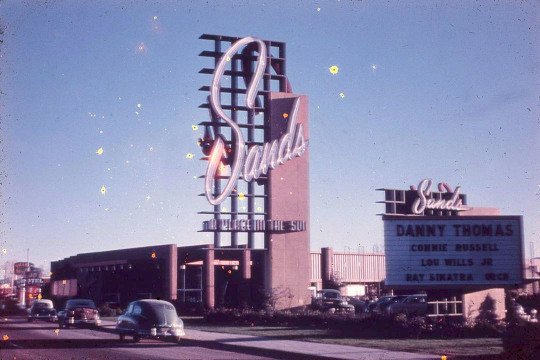
Sands Hotel & Casino '52-'96
Sands, December 1952
Kit Carson Club ('46-'50) Kit Carson Motel ('46-'63) La Lue nightclub ('50-'51)
'46: Kit Carson Club opened by H. Bynum, D. Anderson, G. Frisbee on US Hwy 91 outside of Las Vegas, adjacent to Kit Carson Motel. The club will later become LaRue nightclub, then the Garden Room of the Sands Hotel.
'50: Kit Carson Club reopened as LaRue nightclub opened by Billy Wilkerson, Nola Hahn, 12/23/50.
'51: LaRue closed by summer. Mack Kufferman buys LaRue, and hires architect Wayne McAllister to build around the existing club. Kuffman and partners apply for gaming license. The project is called Sands by 12/51.
Sands ('52-'96)
'52: Kufferman gaming license denied in Apr., sells to Jake Freedman (RG 4/9/52, RG 6/13/52). Partners running the Sands are B. Barron, E. Levinson (casino manager), S. Wyman, J. Entratter (showroom & restaurants). Hidden partners are believed to include J. Stacher, M. Lansky. Sands road sign designed by McAllister, built by YESCO. Sands opens 12/15/52 with 200 rooms in five buildings arranged in Y-shaped layout. The guest wings are named after race tracks: Arlington Park, Belmont Park, Haileah, Rockingham Park, Santa Anita. Three other wings of equal size were added circa ’53-54 (two were named Churchill Downs, Hollywood Park), another by ’58, and larger wing by ’60. The total room count in ’60 was 465.
'53: Frank Sinatra plays his first engagement at the Sands and becomes two percent owner in Oct; Carl Cohen joins the Sands as shareholder and casino manager in Oct.
'54: Sign modification: Second reader board added below the main board, Feb or earlier. Antonio Morelli joins the Sands as musical director for the Copa in Jul.
'55: Sands partners assume control of the Dunes in Sep. They sell the Dunes in four months later.
'58: Jake Freedman dies 1/19/58; Jack Entratter becomes Sands president.
'59: Sign modification: Attraction board attached to the sign, Feb or earlier. Baccarat begins at the Sands. Sands acquires the former Orinda Motel, property to the south, used for expansion of the Sands parking lot.
'60: Sinatra, Dean Martin, Sammy Davis Jr, Peter Lawford, and Joey Bishop (the "Rat Pack") are first billed together in the Copa in Jan-Feb. during the filming of Ocean's 11. Senator John F. Kennedy visits during the Democratic primary campaign.
'63: Opening of Aqueduct hotel wing (83 rm) in Apr. Julius Gabrielle, architect (RJ 4/28/63). Sinatra surrenders ownership 10/7/63.
'64: Sands acquires the former Kit Carson Motel; Belmont and Arlington buildings (base of the Y) moved southward to accommodate construction of a hotel tower.
'65: Second sign in Aug; tower completed late in the year and officially opened Jan. ’66. Martin Stern Jr, architect.
'67: Howard Hughes buys the Sands, 7/23/67. Sinatra leaves his Sands residency after confrontation with Cohen, 9/11/67.
'69: Dean Martin leaves Sands to join Riviera.
'71: Entratter dies, 3/8/71.
'73: Cohen leaves the Sands, Jan. '73.
'80: Inns of America buys the Sands from Hughes heirs Summa Corp in Oct.
'82: Third sign, new porte-cochère, marking the completion of remodeling effort including new Copa room, 1/15/82.
'83: Summa Corp reassumes control of the Sands, 4/5/83.
'88: Kirk Kerkorian buys the Sands in Jan. Kerkorian sells to Interface Group led by Sheldon Addison in Apr.
'90: Sands Expo and Convention Center opens.
'94: Remodeling of the casino.
'96: Sands closes 6/30/96. Tower demolished 11/26/96.
Photos of the Sands
Sources include David G. Schwartz. At the Sands: The Casino That Shaped Classic Las Vegas, Brought the Rat Pack Together, and Went Out With a Bang. December 1952 photo courtesy of Slidetreasurehunt.
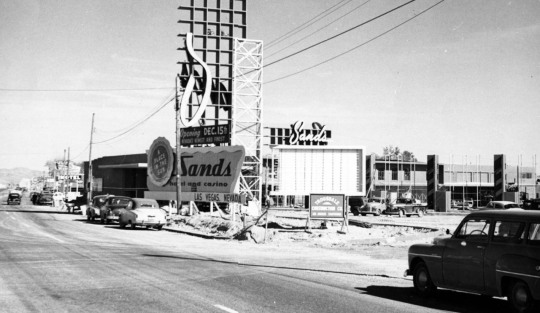


Construction of the sign, 1952. The pylon sign pedestal was 56’ high, 21’ wide, with the S at 34’ tall. Design by Wayne McAllister, fabricated and installed by Young Electric Sign Co. Photo: YESCO Corporate Records (MS-00403), UNLV Special Collections & Archives.
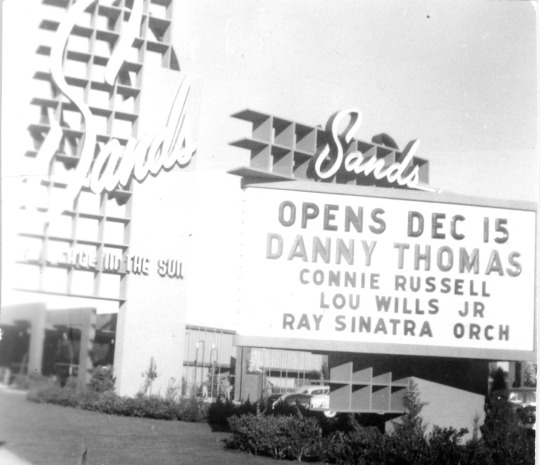
Opens Dec 15. Danny Thomas, Connie Rusell, Lou Wills Jr, Ray Sinatra Orchestra. Nevada State Museum, Las Vegas, 0007-0345.

Aerial view of Kit Carson Motel and the Sands, '62
55 notes
·
View notes
Text
Timeline
Alright, so, the difficulty I first ran into, is that I could not find an exact timeline for releases of Superman content, so through intensive googling, I managed to make a list of releases up to 1960.
1938 (Comics) Action Comics #1-8
1939 (Comics) Action Comics #9-19 | Superman #1-3
1940 (Comics) Action Comics #20-31 | Superman #4-7 (Radio) The Adventures of Superman "The Baby From Krypton" - "The Nitrate Shipment"
1941 (Comics) Action Comics #32-43 | Superman #7-13 | World's Finest Comics #1-4 (Radio) "Black Pearl of Osiris" - "The Pan-Am Highway" (Film) Fleischer Animated Series 1-2
1942 (Comics) Action Comics #44-55 | Superman #14-19 | World's Finest Comics #5-8 (Film) Fleischer Animated Series 3-13 (Radio) "The Mechanical Man" - The Mystery Ship" (Novel) Adventures of Superman by George Lowther
1943 (Comics) Action Comics #56-67 | Superman #20-25 | World's Finest Comics #9-12 (Film) Fleischer Animated Series 14-17 (Radio) ""The Tin Men" - "Stolen War Information"
1944 (Comics) Action Comics #56-79 | Superman #26-31 | World's Finest Comics #13-16 (Radio) "Lois and Jimmy Disappear" - "The Man in the Velvet Shoes"
1945 (Comics) Action Comics #80-91 | Superman #32-37 | More Fun Comics #101 | World's Finest Comics #17-20 (Radio) "The Mystery of the Sleeping Beauty" - "Looking for Kryptonite"
1946 (Comics) Action Comics #92-103 | Superman #38-43 | World's Finest Comics #21-24 (Radio) "The Talking Cat" - "The Phony Restaurant Racket" "Clan of the Fiery Cross"
1947 (Comics) Action Comics #104-115 | Superman #44-49 | World's Finest Comics #25-28 (Radio) "The Phony Inheritance Racket" - "Pennies for Plunder"
1948 (Comics) Action Comics #116-127 | Superman #50-55 | World's Finest Comics #29-32 (Film) Superman Serial (Columbia Pictures starring Kirk Alyn) (Radio) "Hunger Inc." - Superman's Secret"
1949 (Comics) Action Comics #128-139 | Superman #56-61 | Superboy #1-5 | World's Finest Comics #33-37 (Film) Keep Your School All-American (Radio) "The Return of the Octopus" - "Diamond of Death"
1950 (Comics) Action Comics #140-151 | Superman #62-67 | Superboy #6-11 | World's Finest Comics #38-49 (Film) Atom Man vs. Superman (Kirk Alyn)
1951 (Comics) Action Comics #152-163 | Superman #68-73 | Superboy #12-17 | World's Finest Comics #50- (Film) Superman and the Mole Men (George Reeves)
1952 (Comics) Action Comics #163-175 | Superman #74-79 | Superboy #18-23 | World's Finest Comics # (TV) Adventures of Superman (George Reeves) Season 1
1953 (Comics) Action Comics #176-187 | Superman #80-85 | Superboy #24-29 | World's Finest Comics # (Film) Adventures of Superman (George Reeves) Season 2
1954 (Comics) Action Comics #187-199 | Superman #86-93 | Superboy #30-37 | World's Finest Comics (Film) Stamp Day for Superman
1955 (Comics) Action Comics #200-211 | Superman #94-101 | Superboy #38-45 (Film) Adventures of Superman (George Reeves) Season 3
1956 (Comics) Action Comics #212-223 | Superman #102-109 | Superboy #46-53 (Film) Adventures of Superman (George Reeves) Season 4
1957 (Comics) Action Comics #224-235 | Superman #110-117 | Superboy #54-61 (Film) Adventures of Superman (George Reeves) Season 5
1958 (Comics) Action Comics #236-247 | Superman #118-125 | Superboy #62-69 (Film) Adventures of Superman (George Reeves) Season 6
1959 (Comics) Action Comics #248-259 | Superman #126-133 | Superboy #70-77 (Film) George Reeve's death.
1960 (Comics) Action Comics #260-271 | Superman #134-141 | Superboy #78-85 (Film) Superman (Mohammed Hussain)
However, upon joining the Superman subreddit Discord, I was kindly referred to this link on the Superman Supersite:
Which, heh, could have saved me some time. tbh.
3 notes
·
View notes
Text
MARILYN MONROE
June 1, 1926 - August 4, 1962

Marilyn Monroe (born Norma Jeane Mortenson) was an actress, model, and singer. Famous for playing comedic "blonde bombshell" characters, she became one of the most popular sex symbols of the 1950s and early 1960s and was emblematic of the era's changing attitudes towards sexuality. She was a top-billed actress for only a decade, but her films grossed $200 million by the time of her death in 1962. More than half a century later, she continues to be a major popular culture icon.
"When I was five I think, that's when I started wanting to be an actress. I didn't like the world around me because it was kind of grim, but I loved to play house. When I heard that this was acting, I said that's what I want to be. Some of my foster families used to send me to the movies to get me out of the house and there I'd sit all day and way into the night. Up in front, there with the screen so big, a little kid all alone, and I loved it.” ~ Marilyn Monroe,1962

Lucille Ball never worked with Marilyn Monroe, but meet her in 1953 at Ciro’s Nightclub on Sunset Strip, along with Betty Grable, and Red Skelton. Monroe’s immense popularity permeated Ball’s work none-the-less.
At the start of “Changing the Boys’ Wardrobe” (ILL S3;E10) the gang is heading to the movies to see “That picture we’ve been trying to get to for weeks with Marilyn Monroe.” The movie is likely Gentlemen Prefer Blondes, which premiered in New York City in July 1953. On November 5, 1953, the same day the episode was filmed, Monroe’s new film How to Marry a Millionaire was released in the US.
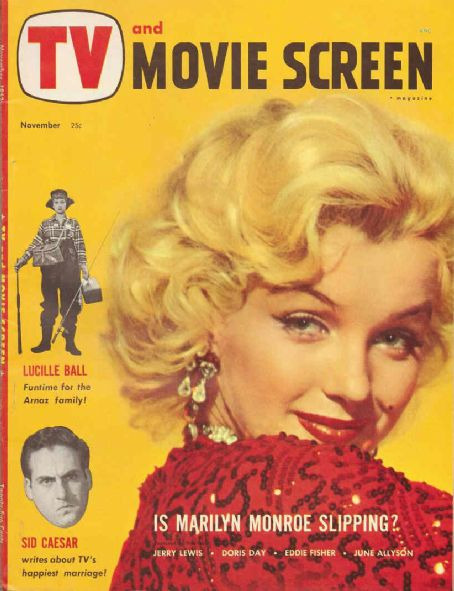
The November 1953 cover of TV and Movie Screen Magazine saw Lucy (in “The Camping Trip”) and Marilyn wearing the dress she wore on the May 1953 cover of Life Magazine promoting Gentlemen Prefer Blondes.
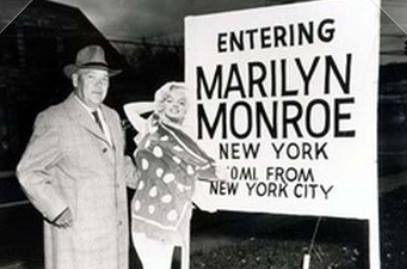
Also on November 5, 1953, the town of Monroe, New York (60 miles from New York City) was temporarily renamed Marilyn Monroe.

The film later inspired much of the plot of “Second Honeymoon” (S5;E14), Lucy’s failed attempt to make their transatlantic crossing to Europe more than just a working vacation.
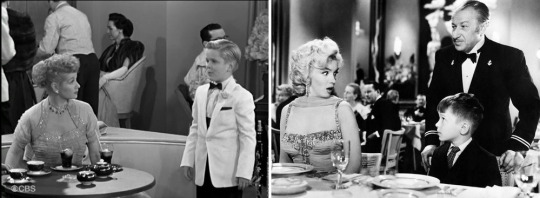
Monroe’s dinner companion turns out to be a seven year-old boy, just like Lucy’s ping pong partner turns out to be young Kenneth Hamilton (Harvey Grant).
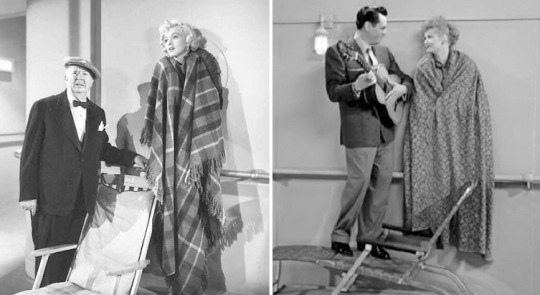
Lucy gets stuck in a porthole just as Monroe did, also draping a blanket around her shoulders so passersby wouldn’t know what was really going on.

The idea for the burlap potato sack dresses in “Lucy Wants A Paris Gown” (ILL S5;E20) comes from Monroe’s real life.

In 1951 Marilyn Monroe took a series of high fashion photographs wearing a potato sack as a response to a journalist who said that she might look sexier in a burlap sack than her usual fashion choices.
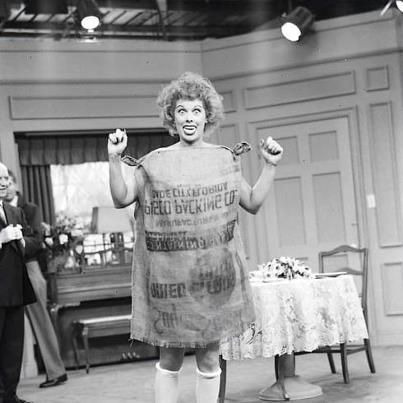
Lucy first wore burlap at the end of “Mr. and Mrs. TV Show” (ILL S4;E24) as her scary version of a Phipps make-over.

In “Ricky’s Movie Offer” (ILL S4;E5) Lucy and Ethel argue about who looks more like Marilyn Monroe.
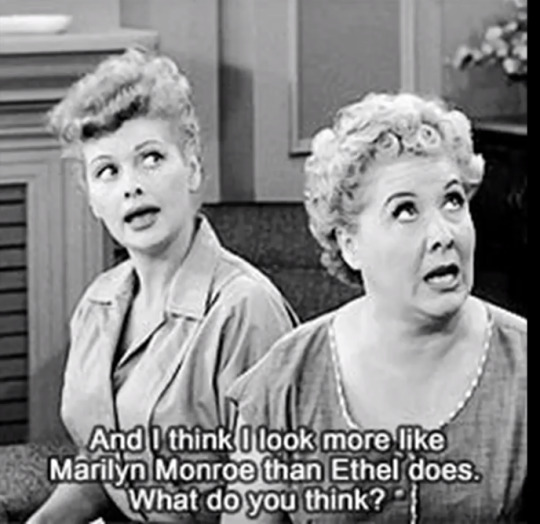
While Lucy has the facial features, Ethel has the blonde hair.

Fred (hilariously) settles the argument!
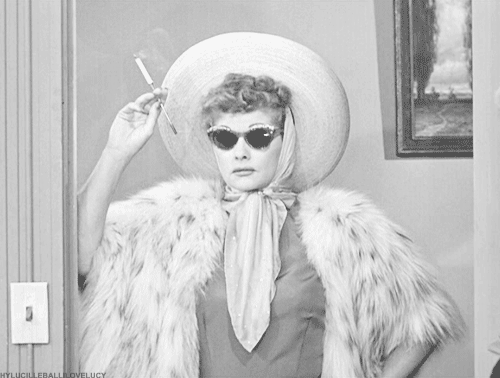
In “Ricky’s Screen Test” (ILL S4;E7) a long list of Hollywood names are dropped in anticipation of hobnobbing with celebrities, including Marilyn Monroe.
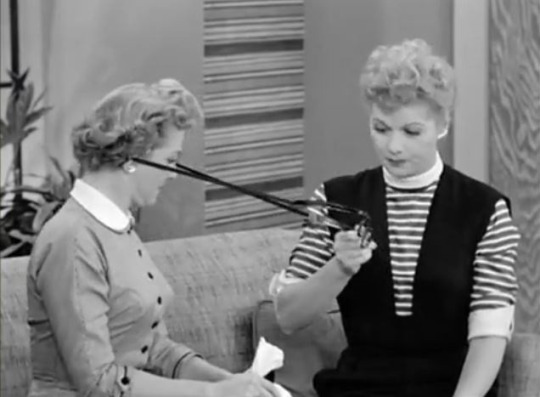
In “Lucy and Harpo Marx” (ILL S4;E28) Lucy wonders if Ethel might pass for Monroe to a near-sighted Carolyn Appleby. After Ethel tries to walk like Marilyn Monroe, Lucy decides that “nobody is that near-sighted!” Fred says that he looks more like Marilyn than either of them!
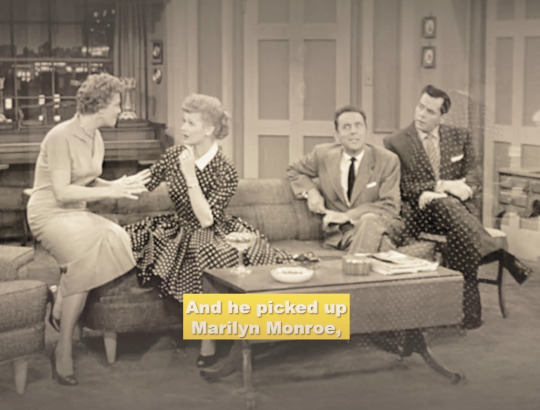
In “Lucy and Superman” (ILL S6;E13), the Appleby’s come over for a social evening that Ethel calls “the bore war” because the couples only talk about their children. As the scene opens, Caroline is in mid-sentence talking about a Marilyn Monroe film.
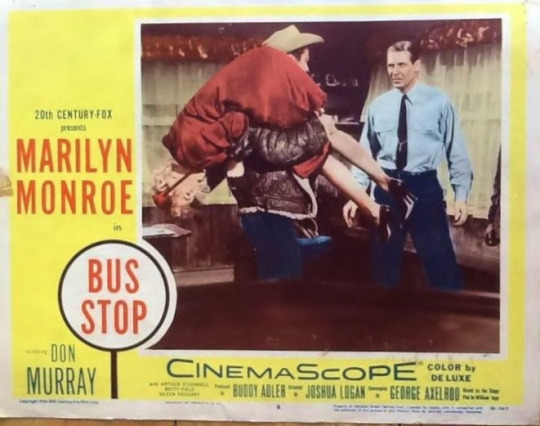
CAROLINE: “...and he picked up Marilyn Monroe, slung her over his shoulder and carried her off!”
Although the title is never mentioned, the film they are discussing is Bus Stop, starring Marilyn Monroe and Don Murray. It was released in August 1956, two and a half months before this episode was filmed.
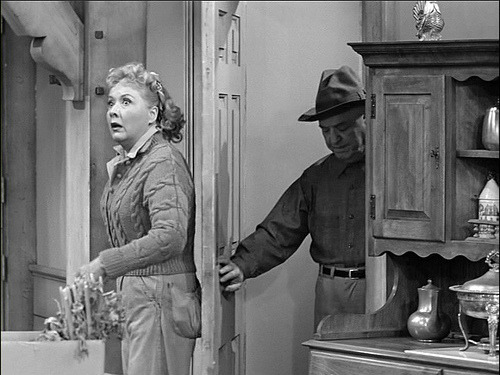
When “Lucy Does the Tango” (ILL S6;E20), she stuffs eggs down her blouse and Ethel stashes a some in her back pockets. Lucy tells her, “Whatever you do don’t try to walk like Marilyn Monroe,” but the ‘yolk’ is on Ethel when Fred suddenly enters through the kitchen door!

In “Lucy the Gun Moll” (TLS S4;E25), Lucy plays Lucy Carmichael and Rusty Martin. The name Rusty Martin was probably derived from Lucy’s hair color and the surname of Mary Martin, who introduced the song “My Heart Belongs to Daddy” (music and lyrics by Cole Porter) in the 1938 Broadway musical Leave It to Me. Marilyn Monroe sang it in the 1960 film Let’s Make Love. In that same film, Harry Cheshire, who played Sam Johnson in “Oil Wells” (ILL S3;E18), played Monroe’s father. Jerry Hausner (Jerry, Ricky’s Agent) and Joan Banks (Reporter Eleanor Harris in “Fan Magazine Interview”) played uncredited supporting roles.

Lucy and Marilyn shared a leading man in handsome Keith Andes. Andes was Lucy’s male lead in Wildcat on Broadway, and later played was featured on three episodes of “The Lucy Show.”
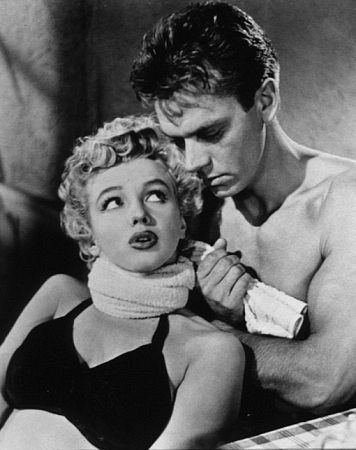
In 1952, he played opposite Marilyn in Clash By Night, an RKO picture.

In “Lucy Gets Ricky on the Radio” (1952), the June 3, 1952 of Look Magazine actually had Lucille Ball and Marilyn Monroe on the cover! Monroe was promoting Clash by Night, and Desi had written a feature on his wife for the magazine. So Marilyn actually did appear on “I Love Lucy” - if only in a still photo.

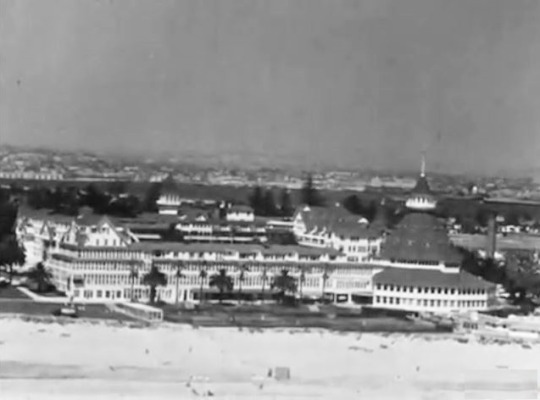
Some Like It Hot (1959) is arguably one of Marilyn Monroe’s most popular films. What does it have in common with Lucille Ball? In 1958, both Lucy and Monroe were depicted at San Diego’s famous Del Coronado Hotel. It is the hotel that the Ricardo’s and Mertzes stay at in “Lucy Goes to Mexico” (LDCH S2;E1) as well as the backdrop for much of the film. Although Desilu filmed establishing footage of the hotel, the cast stayed in Hollywood, while Monroe went on location (as seen above). In “Lucy Goes to a Hollywood Premiere” (TLS S4;E20), Mr. Mooney says he wouldn’t buy a second hand nightie if it had been worn by Jack Lemmon in Some Like It Hot.
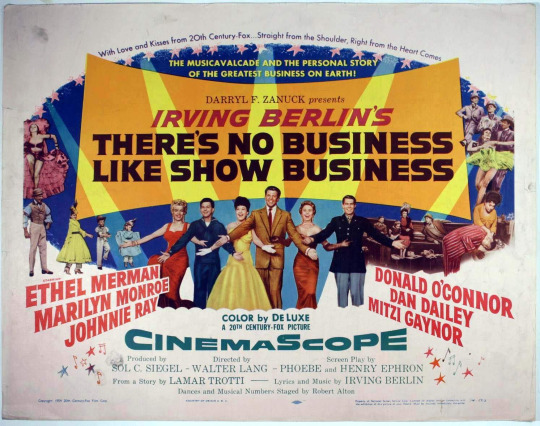
The Irving Berlin song “There’s No Business Like Show Business” was sung on “I Love Lucy” and “The Lucy Show.” Although it was originally from the Broadway musical Annie Get Your Gun (1946), it also served as the title and was performed (by Merman) in the Marilyn Monroe film There’s No Business Like Show Business in 1955.

In 1952, Marilyn co-starred by Richard Widmark (”The Tour” ILL S4;E30) in the film noir drama Don’t Bother To Knock. The film also featured “Lucy” players Lurene Tuttle (Fine Arts League President), Verna Felton (Mrs. Porter), Gloria Blondell (Grace Foster), as well as Harry Bartell, Olan Soule, Robert Foulke, and Bess Flowers.
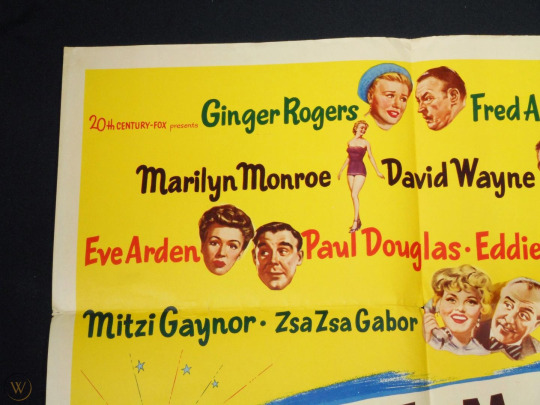
That same year, Monroe starred in We’re Not Married! opposite Lucy’s friend and former co-star Ginger Rogers, as well as Eve Arden (”Hollywood at Last!”), Paul Douglas (”Lucy Wants a Career”) and Eddie Bracken (Too Many Girls).
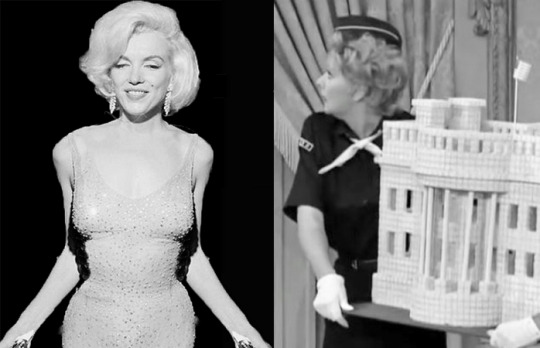
One of Monroe’s most iconic moments came in March 1962 when she sang “Happy Birthday” as a birthday present to President John F. Kennedy in a public birthday celebration also attended by Lucy’s friends and co-stars Jack Benny, Jimmy Durante, Henry Fonda, Danny Kaye, Shirley MacLaine and Elliott Reid. A year later, Lucy Carmichael also gave Kennedy a present, a sugar cube replica of the White House on “The Lucy Show” with Elliott Reid doing Kennedy’s offstage voice as well as playing a small on-camera role!
"I never quite understood it, this sex symbol. I always thought symbols were those things you clash together! That's the trouble, a sex symbol becomes a thing. I just hate to be a thing. But if I'm going to be a symbol of something I'd rather have it sex than some other things they've got symbols of." ~ Marilyn Monroe, 1962
Monroe was married (and divorced) three times:
James Dougherty, Merchant Marine & Policeman (1942-46)
Joe DiMaggio, Baseball Player (1954-55)
Arthur Miller, Playwright (1956-61)

In “Lucy is Enceinte” (ILL S2;E10), Fred gives Lucy a signed baseball for his future 'godson’. When he asks Lucy to read out the signature, she at first says “Spalding,” the ball’s brand name, but then finds it is signed by Joe DiMaggio.

In “Ragtime Band” (ILL S6;E21), Little Ricky asks his Uncle Fred:
LITTLE RICKY: “Who’s Joe 'Maggio?” FRED: “'Who’s Joe 'Maggio?’ You talk more like your father everyday.”
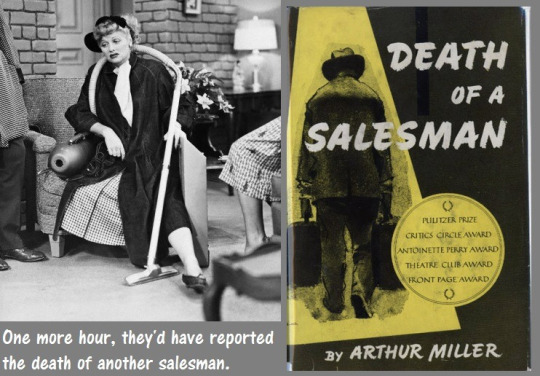
In “Sales Resistance” (ILL S2;E17), Lucy compares herself to Willy Loman, the title character in Death of a Salesman, a Pulitzer Prize-winning play by Arthur Miller first produced on Broadway in 1949 and made into an Oscar-nominated film in 1951.
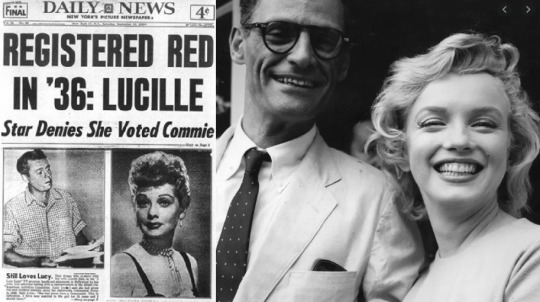
Speaking of husbands, Desi Arnaz has something in common with Marilyn Monroe, too. Both of their souses were accused of being Communists by the House Un-American Activities Committee during the 1950s. Both Lucille and Arthur Miller were cleared of charges and their careers continued, although that was not true for many celebrities of the time.
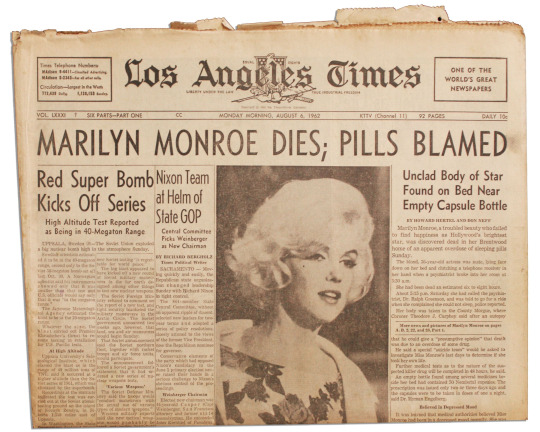
Monroe died on August 4, 1962. The toxicology report showed that the cause of death was acute barbiturate poisoning. Empty medicine bottles were found next to her bed. The possibility that Monroe had accidentally overdosed was ruled out because the dosages found in her body were several times over the lethal limit.
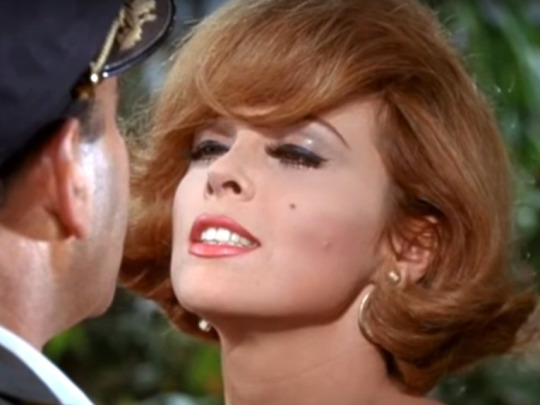
The character of Ginger, the movie star castaway on “Gilligan’s Island” (1964-67) was described during casting as a combination of Lucille Ball and Marilyn Monroe. Tina Louise had Lucy’s red (ginger) hair and Monroe’s shapely physique. The series also featured Natalie Schafer (Phoebe Emerson) as Mrs. Howell, and Alan Hale Jr. as the Skipper. Hale performed on “The Lucy Show” and “Here’s Lucy”. Series creator Sherwood Schwartz was a Lucy fan. His brother Elroy Schwartz actually wrote scripts for Lucille Ball.

In the 2013 web-series “Ryan & Ruby” both Lucille Ball and Marilyn Monroe are given special thanks for their inspiration. The last name of star and creator Ryan Burton's character is "Carmichael", the same as Ball's character on the "The Lucy Show". In Ryan’s kitchen there are fridge magnets with photos of both Lucy and Marilyn.
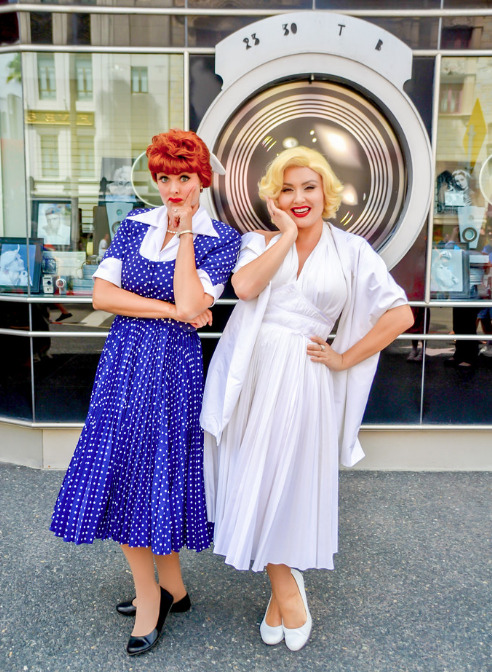
Lucy and Marilyn are street characters at Universal Studios theme parks, their iconic hair and costumes making them instantly recognizable.
The same day Marilyn Monroe was born in 1926, another Hollywood icon with connections to Lucille Ball was also born, Andy Griffith. To read his birthday blog, click here!
#Marilyn Monroe#Lucille Ball#I Love Lucy#William Frawley#Desi Arnaz#vivian vanc#the lucy show#Ryan and Ruby#Gilligan's Island#Tina Louise#Arthur Miller#Joe DiMaggio#Keith Thibodeaux#Alan Hale Jr.#natalie schafer#John F. Kennedy#Paul Douglas#Eve Arden#Ginger Rogers#Verna Felton#Ethel Merman#Richard Widmark#There's No Business Like Show Business#Hotel Del Coronado#Don't Bother To Knock#Some Like It Hot#Look Magazine#Keith Andes#Clash By Night#The Seven Year Itch
50 notes
·
View notes
Link
via Politics – FiveThirtyEight
Pretend I’m the owner of a polling company that surveys political races. I prominently advertise my results: According to a Walt Hickey Polling Inc. survey of 600 likely voters, John Doe is beating Jane Doe 58 percent to 40 percent — John Doe will likely win the election. (Let’s say it’s a race for the U.S. Senate.)
But then you keep reading and you notice that the sample on which my poll is based consists of 400 men and 200 women. You can’t really tell whether I’m adjusting the numbers, and if so, how. Would you trust that number? Unless there’s some state I don’t know about where men outnumber women 2-to-1, you shouldn’t.
So why aren’t we more skeptical of movie ratings that do the same thing?
It’s a worthwhile question, and lately it’s made it pretty hard for us to take the ratings provided on IMDb, the largest and most popular movie site on the internet, at face value. The Academy Awards rightly get criticized for reflecting the preferences of a small, unrepresentative sample of the population, but online ratings have the same problem. Even the vaunted IMDb Top 250 — nominally the best-liked films ever — is worth taking with 250 grains of salt. Women accounted for 52 percent of moviegoers in the U.S. and Canada in 2016, according to the most recent annual study by the Motion Picture Association of America. But on the internet, and on ratings sites, they’re a much smaller percentage.
“If you see any number that is a rating number or a number with a percentage sign, it may be compelling or meaningful and it may not be,” said Gary Langer, the president of Langer Research Associates, the polling firm that has long conducted surveys for ABC News. “And what we need to do rather than be seduced by the number is to subject it to meaningful inquiry as to how it was obtained.”
OK, but how skeptical should we be? To figure that out, I wanted to see how strong the male skew of raters is on IMDb and how big an effect that skew has on movies’ scores.
We’ll start with every film that’s eligible for IMDb’s Top 250 list. A film needs 25,000 ratings from regular IMDb voters to qualify for the list. As of Feb. 14, that was 4,377 titles. Of those movies, only 97 had more ratings from women than men. The other 4,280 films were mostly rated by men, and it wasn’t even close for all but a few films. In 3,942 cases (90 percent of all eligible films), the men outnumbered the women by at least 2-to-1. In 2,212 cases (51 percent), men outnumbered women more than 5-to-1. And in 513 cases (12 percent), the men outnumbered the women by at least 10-to-1.
Looking strictly at IMDb’s weighted average — IMDb adjusts the raw ratings it gets “in order to eliminate and reduce attempts at vote stuffing,” but it does not disclose how — the male skew of raters has a pretty significant effect. In 17 percent of cases, the weighted average of the male and female voters was equal, and in another 26 percent of cases, the votes of the men and women were within 0.1 points of one another. But when there was bigger disagreement — i.e. men and women rated a movie differently by 0.2 points or more, on average — the overall score overwhelmingly broke closer to the men’s rating than the women’s rating. The score was closer to the men’s rating more than 48 percent of the time and closer to the women’s rating less than 9 percent of the time, meaning that when there was disagreement, the male preference won out about 85 percent of the time.
That male skew of raters is also apparent in the 250 movies that make IMDb’s top list, which we pulled on Feb. 16:
So, what’s the issue here? If IMDb is content with its ratings being intended almost solely for men, then there isn’t one. (We reached out to IMDb for comment and for more information on how the site adjusts its ratings, but we received no response. So we don’t know, for example, if IMDb is already doing something to the data that accounts for the gender disparity in raters.) But if IMDb seeks to reflect the opinions of the actual movie-going population, the situation is grave.
Can we fix that? Langer is skeptical. Mainly, besides how simple it is for a dedicated individual or group to “manufacture” results, online data from a self-selected group of people is so inherently dubious that any reweighting of that data is also inherently dubious. You can’t just adjust troublesome data to make it reflect the world, he said.
“The notion that you can take bad data and weight it to be OK is … hazardous to your health,” Langer cautioned.
That said, since the scores of the most popular movie site on the internet are already being calculated based on an entirely self-selected sample, would it destroy the IMDb Top 250 to try to mimic actual movie audiences more? I don’t really think so. As a thought experiment, I used everything we know about IMDb’s rating adjustments — which is far from the full picture — and ran them on the ratings of the 4,377 eligible films after I adjusted the raw ratings to weight men’s and women’s views equally.
We can’t do an adjustment that allows us to perfectly replicate the top 250 — again, we don’t know what’s in the black box, so we can’t re-create it — but to approximate it, I excluded any film that didn’t either a) make the IMDb top 1,000 movies list or b) have a rating from the site’s top 1,000 users within 0.87 points1 of the rating from its users overall. This allows us to sidestep films that would have made the top 250 through vote-stuffing.
My main point is that overall, the naive reweighting didn’t destroy the general look of the 250, and if anything, it elevated films that may have been overlooked because one gender is vastly outnumbered.2
What if IMDb adjusted ratings toward gender parity?
Estimated highest-ranking films on IMDb if the men’s and women’s ratings were weighted toward 50-50 vs. IMDb’s actual rank as of Feb. 16, 2018
Rankings Year▲▼ Film▲▼ Actual▲▼ Women only▲▼ Men only▲▼ Gender- weighted▲▼ 1994 The Shawshank Redemption 1 1 1 1 1972 The Godfather 2 10 2 2 2008 The Dark Knight 4 3 3 3 2003 The Lord of the Rings: The Return of the King 8 2 4 4 1993 Schindler’s List 6 6 11 5 1999 Fight Club 10 5 8 6 2001 The Lord of the Rings: The Fellowship of the Ring 11 7 10 7 1957 12 Angry Men 5 27 7 8 1974 The Godfather: Part II 3 22 5 9 2010 Inception 14 8 6 10 1994 Forrest Gump 12 9 13 11 2002 The Lord of the Rings: The Two Towers 15 11 14 12 1994 The Lion King 47 4 29 13 1994 Pulp Fiction 7 15 9 14 2014 Interstellar 30 25 15 15 1999 The Green Mile 32 12 28 16 1975 One Flew Over the Cuckoo’s Nest 16 24 19 17 1966 The Good, the Bad and the Ugly 9 115 12 18 2006 The Prestige 48 26 16 19 1998 American History X 31 17 27 20 2012 The Dark Knight Rises 65 23 22 21 1997 Life Is Beautiful 25 16 41 22 1980 Star Wars: Episode V – The Empire Strikes Back 13 41 17 23 1994 Leon: The Professional 27 21 37 24 2002 City of God 21 64 20 25 1995 Se7en 22 28 23 26 2001 Spirited Away 28 13 56 27 1991 The Silence of the Lambs 23 20 33 28 2006 The Departed 40 35 26 29 1990 Goodfellas 17 71 18 30 2011 The Intouchables 37 19 52 31 2014 Whiplash 45 54 30 32 2000 Gladiator 46 44 24 33 2012 Django Unchained 60 29 31 34 2002 The Pianist 39 31 53 35 1946 It’s a Wonderful Life 24 56 51 36 1960 Psycho 34 55 40 37 1977 Star Wars: Episode IV – A New Hope 20 48 32 38 2009 Inglourious Basterds 97 32 43 39 1998 Saving Private Ryan 29 70 25 40 1995 The Usual Suspects 26 58 36 41 1999 The Matrix 18 62 21 42 2000 Memento 49 57 34 43 1942 Casablanca 36 73 42 44 1999 American Beauty 63 51 35 45 1985 Back to the Future 44 49 46 46 2001 A Beautiful Mind 144 34 68 47 1954 Rear Window 43 80 60 48 2000 Requiem for a Dream 80 50 49 49 2011 Harry Potter and the Deathly Hallows: Part 2 218 14 126 50 2006 The Lives of Others 58 86 78 51 2010 Shutter Island 177 39 59 52 2008 WALL-E 62 42 62 53 2004 Eternal Sunshine of the Spotless Mind 87 38 66 54 1980 The Shining 61 61 47 55 1997 Good Will Hunting 102 60 48 56 1971 A Clockwork Orange 84 79 50 57 2001 Amelie 82 30 90 58 1954 Seven Samurai 19 336 39 59 1983 Star Wars: Episode VI – Return of the Jedi 76 87 63 60 1992 Reservoir Dogs 77 94 64 61 2017 Coco 51 209 166 62 1988 Cinema Paradiso 54 165 97 63 1979 Apocalypse Now 50 219 38 64 1940 The Great Dictator 53 262 101 65 1950 Sunset Boulevard 55 190 108 66 1931 City Lights 35 294 92 67 1997 Princess Mononoke 64 118 100 68 2015 Room 143 82 139 69 2003 Pirates of the Caribbean: The Curse of the Black Pearl > 250 36 113 70 2004 Howl’s Moving Castle 137 43 216 71 1962 To Kill a Mockingbird 89 102 135 72 2009 Up 115 37 117 73 2014 Gone Girl 179 81 70 74 2010 Toy Story 3 98 66 82 75 1936 Modern Times 38 248 96 76 1988 Grave of the Fireflies 57 159 133 77 2006 Pan’s Labyrinth 130 74 91 78 2016 Hacksaw Ridge 175 161 124 79 1968 2001: A Space Odyssey 91 195 54 80 2007 Into the Wild 181 84 95 81 1958 Vertigo 72 154 87 82 2015 Inside Out 140 78 107 83 2005 Batman Begins 116 106 58 84 1975 Monty Python and the Holy Grail 103 123 104 85 2009 3 Idiots 93 203 93 86 2003 Oldeuboi 67 171 73 87 1964 Dr. Strangelove or: How I Learned to Stop Worrying and Love the Bomb 56 236 57 88 1991 Terminator 2 42 178 44 89 1959 North by Northwest 74 205 99 90 1968 Once Upon a Time in the West 33 447 55 91 1981 Raiders of the Lost Ark 41 131 65 92 1995 Toy Story 94 85 80 93 1952 Singin’ in the Rain 90 110 170 94 2016 La La Land 207 122 86 95 1979 Alien 52 151 67 96 1941 Citizen Kane 71 188 74 97 2002 Catch Me if You Can 219 97 81 98 1983 Scarface 105 181 69 99 1976 Taxi Driver 88 164 71 100 2014 The Grand Budapest Hotel 194 65 128 101 1987 Full Metal Jacket 92 177 83 102 2010 How to Train Your Dragon 176 47 165 103 1984 Amadeus 83 128 121 104 2007 There Will Be Blood 165 212 72 105 2012 The Avengers > 250 52 144 106 1984 Once Upon a Time in America 69 337 88 107 2013 The Wolf of Wall Street 150 158 45 108 2005 V for Vendetta 151 76 112 109 1939 Gone With the Wind 157 46 279 110 2003 Kill Bill: Vol. 1 174 89 114 111 1995 Braveheart 75 141 61 112 2003 Finding Nemo 166 53 151 113 1999 The Sixth Sense 160 75 116 114 2011 The Help 241 33 245 115 2015 Star Wars: The Force Awakens > 250 92 154 116 2015 Mad Max: Fury Road 204 135 79 117 2000 Snatch 100 144 76 118 2016 Dangal 73 649 195 119 2016 Zootopia > 250 95 187 120 2001 Donnie Darko 226 91 122 121 2008 Gran Torino 158 121 120 122 1989 Indiana Jones and the Last Crusade 112 156 84 123 2012 Jagten 101 183 141 124 1988 My Neighbor Totoro 132 112 183 125 1996 Trainspotting 156 107 127 126 2013 12 Years a Slave 201 100 131 127 1959 Some Like It Hot 118 124 186 128 1973 The Sting 95 284 143 129 2013 Prisoners 215 148 98 130 2017 Logan 202 193 103 131 2016 Your Name 79 399 190 132 2007 Taare Zameen Par 81 448 138 133 2011 A Separation 109 242 125 134 1997 Titanic > 250 45 188 135 2011 Warrior 154 213 134 136 2017 Dunkirk 236 192 145 137 2015 Spotlight 205 155 152 138 1986 Stand by Me 192 125 184 139 2014 X-Men: Days of Future Past > 250 113 159 140 2004 Kill Bill: Vol. 2 > 250 116 157 141 2014 The Imitation Game > 250 69 209 142 2010 The King’s Speech > 250 59 206 143 1986 Aliens 68 217 85 144 2004 Downfall 121 288 115 145 1998 Lock, Stock and Two Smoking Barrels 142 199 130 146 1997 L.A. Confidential 106 225 94 147 2016 Arrival > 250 169 137 148 1957 Paths of Glory 59 704 109 149 2017 Blade Runner 2049 147 368 102 150 1991 Beauty and the Beast 247 40 379 151 2014 Guardians of the Galaxy > 250 111 147 152 1962 Lawrence of Arabia 85 396 105 153 1993 Jurassic Park 198 150 118 154 1927 Metropolis 108 331 182 155 2016 Deadpool > 250 126 155 156 2012 The Hobbit: An Unexpected Journey > 250 90 192 157 2001 Monsters, Inc. 224 77 196 158 1988 Die Hard 122 220 77 159 1989 Dead Poets Society 238 103 239 160 2010 Black Swan > 250 98 161 161 2015 The Martian > 250 134 160 162 1957 Witness for the Prosecution 66 476 229 163 2004 Hotel Rwanda 190 176 181 164 2009 Star Trek > 250 117 199 165 2013 The Hobbit: The Desolation of Smaug > 250 109 205 166 2009 Hachi: A Dog’s Tale 212 127 288 167 2017 Three Billboards Outside Ebbing, Missouri 111 351 204 168 1981 Das Boot 70 603 111 169 1995 Heat 123 332 89 170 1978 The Deer Hunter 159 346 153 171 1980 The Elephant Man 148 261 177 172 1931 M 78 465 167 173 1950 All About Eve 114 227 302 174 1921 The Kid 99 459 249 175 1944 Double Indemnity 86 433 169 176 2013 Her > 250 194 106 177 2009 Mary and Max 178 175 274 178 2017 Thor: Ragnarok > 250 200 260 179 2013 Dallas Buyers Club > 250 146 175 180 1960 The Apartment 107 322 189 181 2008 In Bruges > 250 239 140 182 1998 The Truman Show 206 132 149 183 2010 Incendies 131 300 253 184 1939 The Wizard of Oz 232 119 241 185 2008 Slumdog Millionaire > 250 99 191 186 2007 No Country for Old Men 162 244 75 187 1999 The Boondock Saints > 250 254 250 188 2009 The Secret in Their Eyes 135 265 198 189 2016 Lion > 250 170 332 190 2017 Baahubali 2: The Conclusion > 250 1170 343 191 2015 The Revenant > 250 214 129 192 2004 Million Dollar Baby 203 163 162 193 2005 Babam ve Oglum 117 526 291 194 1963 The Great Escape 126 479 174 195 1948 Bicycle Thieves 96 458 202 196 2004 Harry Potter and the Prisoner of Azkaban > 250 72 339 197 2006 Blood Diamond > 250 172 212 198 1993 The Nightmare Before Christmas > 250 105 318 199 1974 Chinatown 129 360 158 200 2012 The Perks of Being a Wallflower > 250 108 232 201 1990 Edward Scissorhands > 250 67 357 202 1949 The Third Man 127 484 224 203 2003 Big Fish > 250 133 226 204 2013 Rush 193 252 172 205 1954 Dial M for Murder 155 352 233 206 1995 Before Sunrise 211 179 228 207 1940 Rebecca 173 250 350 208 1992 Unforgiven 120 543 110 209 1979 Life of Brian 183 266 179 210 1998 The Big Lebowski 167 256 123 211 1992 Aladdin > 250 120 308 212 2000 Amores Perros 209 260 225 213 2007 The Bourne Ultimatum 234 235 156 214 2007 Ratatouille > 250 138 211 215 1996 Fargo 161 230 164 216 1995 Twelve Monkeys 245 238 163 217 1965 For a Few Dollars More 104 792 142 218 1980 Raging Bull 124 599 119 219 2005 Serenity > 250 208 295 220 1967 Cool Hand Luke 172 539 215 221 1969 Butch Cassidy and the Sundance Kid 210 421 231 222 1957 The Bridge on the River Kwai 138 581 180 223 1988 Rain Man > 250 182 217 224 1965 The Sound of Music > 250 101 516 225 1957 The Seventh Seal 141 462 223 226 1993 In the Name of the Father 188 408 268 227 2014 Wild Tales 185 323 282 228 1939 Mr. Smith Goes to Washington 145 466 297 229 2006 The Pursuit of Happyness > 250 185 220 230 1995 Casino 146 419 136 231 1987 The Princess Bride 214 136 298 232 1950 Rashomon 110 626 185 233 2008 Iron Man > 250 140 244 234 1975 Dog Day Afternoon > 250 417 252 235 2014 PK > 250 646 246 236 2005 Sin City > 250 231 148 237 1954 On the Waterfront 139 546 237 238 1982 Gandhi 227 370 221 239 2017 Call Me by Your Name 186 347 528 240 2011 X: First Class > 250 157 248 241 1948 The Treasure of the Sierra Madre 119 786 230 242 2014 Kingsman: The Secret Service > 250 174 259 243 2012 Life of Pi > 250 152 257 244 2016 Captain America: Civil War > 250 215 265 245 2005 Harry Potter and the Goblet of Fire > 250 96 431 246 2004 The Notebook > 250 63 452 247 1976 Rocky 220 442 132 248 2013 About Time > 250 189 269 249 1977 Annie Hall 233 289 218 250 2003 Mystic River > 250 245 219 251 2011 The Girl With the Dragon Tattoo > 250 216 222 252 1992 Scent of a Woman > 250 276 255 253 2007 Atonement > 250 139 366 254 2011 The Artist > 250 197 325 255 2014 Big Hero 6 > 250 129 462 256 1986 Platoon 187 490 176 257 1984 Nausicaa of the Valley of the Wind 213 378 301 258 1973 The Exorcist > 250 309 178 259 1925 The Gold Rush 136 684 306 260 1953 Roman Holiday > 250 206 426 261 1982 The Thing 163 528 146 262 1984 The Terminator 229 318 150 263 1985 The Breakfast Club > 250 137 391 264 2007 Persepolis > 250 291 477 265 2004 Before Sunset > 250 263 240 266 1959 Ben-Hur 195 481 227 267 1961 Judgment at Nuremberg 134 752 375 268 2013 The Hunger Games: Catching Fire > 250 83 525 269 2004 The Incredibles > 250 222 208 270 2000 Remember the Titans > 250 312 346 271 2001 Shrek > 250 143 323 272 1934 It Happened One Night 184 366 424 273 2001 Harry Potter and the Sorcerer’s Stone > 250 88 530 274 2006 Casino Royale > 250 282 200 275 2014 Edge of Tomorrow > 250 293 203 276 2014 How to Train Your Dragon 2 > 250 186 395 277 1941 The Maltese Falcon 216 541 271 278 2014 Birdman or (The Unexpected Virtue of Ignorance) > 250 299 168 279 1974 Young Frankenstein > 250 443 334 280 1957 Wild Strawberries 152 609 329 281 2001 Ocean’s Eleven > 250 221 262 282 2004 Shaun of the Dead > 250 233 261 283 1967 The Graduate > 250 285 254 284 2006 The Fall > 250 223 594 285 1995 La Haine 231 561 276 286 2006 Little Miss Sunshine > 250 149 349 287 2003 Dogville > 250 328 365 288 2015 The Hateful Eight > 250 411 171 289 2005 Pride & Prejudice > 250 68 754 290 2014 Nightcrawler > 250 380 173 291 1990 Dances With Wolves > 250 375 264 292 1986 Castle in the Sky 250 379 310 293 2010 Tangled > 250 93 599 294 1999 The Iron Giant > 250 418 312 295 2000 In the Mood for Love 240 358 423 296 2016 Hidden Figures > 250 180 651 297 2008 Yip Man > 250 744 214 298 1951 Strangers on a Train > 250 478 371 299 1948 Rope > 250 503 369 300 2009 Moon > 250 350 284 301 2016 Manchester by the Sea > 250 427 243 302 1951 A Streetcar Named Desire > 250 348 448 303 1986 Ferris Bueller’s Day Off > 250 255 303 304 2001 Mulholland Drive > 250 349 242 305 2014 Captain America: The Winter Soldier > 250 204 316 306 2009 District 9 > 250 324 193 307 1982 Blade Runner 149 341 197 308 1999 Magnolia > 250 444 194 309 1985 Brazil > 250 554 287 310 2002 The Bourne Identity > 250 298 256 311 2002 Hero > 250 492 355 312 2005 Cinderella Man > 250 495 286 313 2000 Crouching Tiger, Hidden Dragon > 250 354 313 314 1999 Toy Story 2 > 250 249 266 315 2013 Star Trek: Into Darkness > 250 191 417 316 1968 Rosemary’s Baby > 250 343 304 317 1946 Notorious > 250 500 450 318 1976 Network 191 720 273 319 2016 Rogue One > 250 283 337 320 1997 Children of Heaven 128 678 519 321 2007 Hot Fuzz > 250 259 331 322 1983 A Christmas Story > 250 415 377 323 2004 Crash > 250 226 336 324 2010 Harry Potter and the Deathly Hallows: Part 1 > 250 104 696 325 1995 Dilwale Dulhania Le Jayenge > 250 902 437 326 2013 Captain Phillips > 250 270 340 327 2005 Walk the Line > 250 224 418 328 2017 Guardians of the Galaxy Vol. 2 > 250 241 446 329 2007 Elite Squad > 250 974 307 330 1982 E.T. the Extra-Terrestrial > 250 246 370 331 2000 Dancer in the Dark > 250 400 447 332 1966 Persona 196 548 400 333 2009 The Girl With the Dragon Tattoo > 250 269 412 334 2008 Let the Right One In > 250 384 270 335 2014 Boyhood > 250 335 238 336 2012 Barfi! > 250 877 440 337 2009 Mr. Nobody > 250 253 434 338 1993 True Romance > 250 557 280 339 2010 My Name Is Khan > 250 535 517 340 2009 The Hangover > 250 258 247 341 1926 The General 153 891 381 342 2012 Moonrise Kingdom > 250 232 386 343 2012 Les Miserables > 250 168 499 344 1979 Stalker 197 767 347 345 2017 Baby Driver > 250 389 305 346 2012 Silver Linings Playbook > 250 237 251 347 2016 Contratiempo > 250 589 561 348 2004 The Sea Inside > 250 428 507 349 2006 Apocalypto > 250 364 373 350 1959 The 400 Blows 200 637 374 351 2017 Get Out > 250 344 314 352 1988 Akira > 250 882 267 353 1964 Fistful of Dollars > 250 950 278 354 2009 The Blind Side > 250 198 488 355 2008 Taken > 250 257 315 356 2008 The Curious Case of Benjamin Button > 250 211 320 357 2007 The Diving Bell and the Butterfly > 250 432 397 358 2011 Drive > 250 361 207 359 2003 Spring, Summer, Fall, Winter… and Spring > 250 572 416 360 1987 The Untouchables > 250 604 300 361 1944 Arsenic and Old Lace > 250 464 617 362 1996 Sling Blade > 250 715 464 363 2008 The Boy in the Striped Pajamas > 250 207 601 364 2002 Talk to Her > 250 394 430 365 1979 Manhattan > 250 508 359 366 2013 Short Term 12 > 250 474 529 367 2015 Straight Outta Compton > 250 513 459 368 2010 Despicable Me > 250 145 543 369 2000 Almost Famous > 250 320 322 370 1982 Pink Floyd: The Wall > 250 656 510 371 2006 Children of Men > 250 355 263 372 2014 Ex Machina > 250 362 272 373 1997 Boogie Nights > 250 660 213 374 2013 Queen > 250 1005 484 375 1973 Papillon > 250 831 354 376 2010 Elite Squad: The Enemy Within > 250 1116 352 377 2014 The Theory of Everything > 250 173 591 378 1940 The Philadelphia Story > 250 393 766 379 1940 The Grapes of Wrath 221 728 403 380 1971 Harold and Maude > 250 436 685 381 2016 Captain Fantastic > 250 363 505 382 1993 What’s Eating Gilbert Grape > 250 202 574 383 2003 Memories of Murder 199 916 330 384 2009 Avatar > 250 228 296 385 2002 Infernal Affairs 243 875 292 386 1994 Three Colors: Red > 250 644 415 387 1976 All the President’s Men > 250 755 420 388 2016 The Handmaiden 246 595 549 389 1955 The Night of the Hunter > 250 737 471 390 1995 Underground > 250 751 541 391 1990 The Godfather: Part III > 250 440 358 392 1984 Paris, Texas 244 736 455 393 2010 The Fighter > 250 452 283 394 1966 Who’s Afraid of Virginia Woolf? > 250 537 565 395 2014 The Fault in Our Stars > 250 187 513 396 2005 Brokeback Mountain > 250 162 611 397 2007 Chak de! India > 250 1278 317 398 2006 Lucky Number Slevin > 250 416 363 399 1991 JFK > 250 847 324 400 1998 The Legend of 1900 242 608 607 401 2017 The Greatest Showman > 250 272 972 402 2000 O Brother, Where Art Thou? > 250 401 387 403 2010 The Social Network > 250 414 201 404 1997 Gattaca > 250 356 390 405 2012 Argo > 250 243 409 406 1993 Groundhog Day 230 457 210 407 1962 The Manchurian Candidate > 250 849 506 408 1984 This Is Spinal Tap > 250 762 348 409 2013 Frozen > 250 130 692 410 1990 Misery > 250 402 466 411 2007 The Man From Earth > 250 764 290 412 1968 Planet of the Apes > 250 789 294 413 2000 Cast Away > 250 314 328 414 1998 Black Cat, White Cat > 250 676 605 415 1971 Willy Wonka & the Chocolate Factory > 250 333 496 416 1985 Ran 133 1207 234 417 2008 Changeling > 250 296 405 418 2006 Rang De Basanti 180 1218 236 419 1989 Glory > 250 768 427 420 1989 Back to the Future Part II > 250 374 338 421 2004 The Bourne Supremacy > 250 413 333 422 2006 Letters From Iwo Jima > 250 791 364 423 1952 High Noon > 250 890 407 424 1997 The Fifth Element > 250 247 546 425 2017 Wonder Woman > 250 196 706 426 1995 Ghost in the Shell > 250 917 361 427 1961 Yojimbo 113 1281 235 428 2015 Bahubali: The Beginning > 250 1491 393 429 2007 Zodiac > 250 435 275 430 1990 Awakenings > 250 467 559 431 1993 Three Colors: Blue > 250 552 603 432 1950 Harvey > 250 645 680 433 2014 Fury > 250 449 341 434 1993 Philadelphia > 250 277 644 435 1998 The Celebration > 250 785 404 436 1946 The Big Sleep > 250 750 489 437 1987 Wings of Desire > 250 622 638 438 2016 Hunt for the Wilderpeople > 250 605 701 439 1994 Chungking Express > 250 712 600 440 2012 Kahaani > 250 1212 478 441 1958 Touch of Evil 228 1008 356 442 2004 Finding Neverland > 250 240 570 443 2004 The Machinist > 250 330 438 444 1987 Empire of the Sun > 250 530 668 445 2012 Wreck-It Ralph > 250 281 458 446 1968 Night of the Living Dead > 250 837 385 447 1993 Carlito’s Way > 250 876 326 448 1996 The Bandit 171 1181 362 449 1997 The Game > 250 441 367 450 1946 The Best Years of Our Lives 239 772 604 451 2004 Man on Fire > 250 406 444 452 2014 The Lego Movie > 250 397 380 453 1964 Mary Poppins > 250 234 806 454 1959 Anatomy of a Murder > 250 864 515 455 1999 Being John Malkovich > 250 392 383 456 2015 The Big Short > 250 515 299 457 2008 The Wrestler > 250 621 289 458 1954 La Strada > 250 748 623 459 1999 All About My Mother > 250 405 712 460 2007 3:10 to Yuma > 250 511 456 461 1975 Barry Lyndon 225 991 281 462 2009 Fantastic Mr. Fox > 250 423 445 463 1922 Nosferatu > 250 716 468 464 2017 Wonder > 250 577 862 465 2006 The Last King of Scotland > 250 455 535 466 1980 The Blues Brothers > 250 687 372 467 2012 Skyfall > 250 295 401 468 1997 As Good as It Gets > 250 367 396 469 1955 Diabolique 223 910 534 470 2016 Kubo and the Two Strings > 250 600 616 471 1972 Solaris > 250 996 429 472 2013 Before Midnight > 250 453 449 473 1989 Kiki’s Delivery Service > 250 357 674 474 1994 Ed Wood > 250 545 384 475 1960 La Dolce Vita > 250 793 512 476 1993 The Fugitive > 250 569 392 477 1967 Bonnie and Clyde > 250 648 501 478 1996 Primal Fear > 250 426 578 479 2002 Harry Potter and the Chamber of Secrets > 250 142 831 480 1999 The Insider > 250 863 378 481 2004 3-Iron > 250 651 719 482 1965 Doctor Zhivago > 250 714 577 483 1927 Sunrise 164 995 633 484 2009 Zombieland > 250 329 414 485 2001 Lagaan: Once Upon a Time in India 249 1190 293 486 1993 Tombstone > 250 794 526 487 2008 Departures > 250 731 613 488 2009 (500) Days of Summer > 250 310 345 489 1969 Midnight Cowboy > 250 818 502 490 1961 Breakfast at Tiffany’s > 250 210 802 491 2007 Harry Potter and the Order of the Phoenix > 250 147 837 492 2004 The Butterfly Effect > 250 303 428 493 2003 21 Grams > 250 410 500 494 2016 Doctor Strange > 250 287 556 495 2009 Harry Potter and the Half-Blood Prince > 250 160 846 496 1953 Stalag 17 > 250 1059 642 497 1962 What Ever Happened to Baby Jane? > 250 585 793 498 2007 Once > 250 463 487 499 2013 Mandariinid > 250 666 865 500
IMDb makes adjustments to its raw ratings but does not disclose its methodology. Therefore, these rankings — which start with the raw ratings — may not match a gender-weighted version of a list made by IMDb itself because we can’t re-create the site’s adjustments.
Source: IMDb
The top 100 largely includes films from the original list of 250, and the additions to the list — there are a lot of best picture winners among the newbies — appear mainly in the back half of the 250.
Attempting to reflect a target population is a common practice in many fields that use surveys. It’s not clear to me why movie rating sites don’t do it — or, at the least, why they don’t indicate that their scores are almost all based mostly on the opinions of male users.
4 notes
·
View notes
Text
2017 Movie Odyssey
So ends the 2017 Movie Odyssey. Last year, I wrote that I did not foresee ever surpassing the 200+ movie mark for a long, long time. But look what happened here (outside of May because that was a hectic time in the Master’s program for sure). The 2017 Movie Odyssey consisted of 232 films - 180 feature-length films and fifty-two shorts. A century of filmmaking was covered this year, from 1917 to 2017. If I do have one regret this year... it’s that African films were not featured this year (due to availability issues and me not having enough money; I tend to watch things legally if possible). I hope to assuage that next year for a more representative Movie Odyssey.
For all of you out there who supported the Movie Odyssey in your own ways – whether reading, liking, commenting, or reblogging a write-up or sitting down with me to a new movie or talking to me about any movie... my thanks to all of you. None of this possible without you, and I hope you find that, through this blog, classic movies seem more approachable and welcoming and you are inspired to see some and learn about them yourself. A Happy New Year to all, and I’ll see you for the 2018 leg of the Movie Odyssey very soon (oh boy the Winter Olympics and World Cup are gonna chip away at the final count next year)!
As many know, all ratings are based on my imdb rating and half-points are always rounded down. My interpretation of that ratings system can be found here. A 6/10 is considered the borderline between “passing” and “failing”. Feature-length narrative films, short films, and documentaries are rated within their respective spectrums.
JANUARY
1. Marnie (1964) – 6/10 2. The Moon Is Down (1943) – 7/10 3. Sense and Sensibility (1995) – 8.5/10 4. The Big House (1930) – 7.5/10 5. Manchester by the Sea (2016) – 7/10 6. The Far Country (1954) – 7/10 7. Kung Fu Hustle (2004, Hong Kong/China) – 7/10 8. Road to Singapore (1940) – 6/10 9. A Clever Dummy (1917 short) – 5/10 10. Hidden Figures (2016) – 7.5/10 11. Teddy at the Throttle (1917 short) – 7.5/10 12. The Last of the Mohicans (1920) – 7/10 13. Sweet Smell of Success (1957) – 10/10 14. The Red Turtle (2016, France/Belgium/Japan) – 9/10 15. Life, Animated (2016) – 7.5/10 16. In the Mood for Love (2000, Hong Kong) – 10/10
FEBRUARY
17. Lion (2016) – 7/10 18. It’s Always Fair Weather (1955) – 7.5/10 19. Fences (2016) – 8.5/10 20. Shenandoah (1965) – 7/10 21. Caged (1950) – 8/10 22. Pearl (2016 short) – 7.5/10 23. Blind Vaysha (2016 short) – 8/10 24. Asteria (2016 short) – 6/10 25. The Head Vanishes (2016 short) – 6/10 26. Once Upon a Line (2016 short) – 7/10 27. Pear Cider and Cigarettes (2016 short) – 8/10 28. Sing (2016 short, Hungary) – 7.5/10 29. Silent Nights (2016 short, Denmark) – 6/10 30. Timecode (2016 short, Spain) – 7/10 31. Ennemis intérieurs (2016 short, France) – 8.5/10 32. La femme et le TGV (2016 short, Switzerland) – 8/10 33. Joe’s Violin (2016 short) – 7/10 34. Extremis (2016 short) – 8/10 35. 4.1 Miles (2016 short, Greece) – 9/10 36. Nashville (1975) – 7.5/10 37. The Romance of Transportation in Canada (1952 short) – 7/10
MARCH
38. My Life as a Zucchini (2016, Switzerland) – 8/10 39. Lili (1953) – 7/10 40. The Man from U.N.C.L.E. (2015) – 6/10 41. Captain Blood (1935) – 9.5/10 42. Logan (2017) – 7/10 43. Friendly Persuasion (1956) – 9/10 44. Ducks and Drakes (1921) – 7/10 45. What Dreams May Come (1998) – 6/10 46. Bright Road (1953) – 6/10 47. Snow Gets in Your Eyes (1938 short) – 5/10 48. Jungle Cat (1959) – 6.5/10 49. The Salesman (2016, Iran) – 8.5/10 50. Good Scouts (1938 short) – 7.5/10 51. All in a Nutshell (1949 short) – 8/10 52. The Hound That Thought He Was a Raccoon (1960) – 7/10 53. Winter Storage (1949 short) – 7/10 54. Out of Scale (1951 short) – 8/10 55. The Incredible Journey (1963) – 7/10 56. Follow Me, Boys! (1966) – 7/10 57. Charlie, the Lonesome Cougar (1967) – 5.5/10 58. Belladonna of Sadness (1973, Japan) – 6/10 59. Ponyo (2008, Japan) – 7/10 60. My Cousin Rachel (1952) – 7.5/10 61. Road to Perdition (2002) – 9/10
APRIL
62. The X from Outer Space (1967, Japan) – 3/10 63. The Blue Gardenia (1953) – 6.5/10 64. Get Out (2017) – 7.5/10 65. Fantastic Planet (1973, France/Czechoslovakia) – 8/10 66. 5 Centimeters Per Second (2007, Japan) – 6/10 67. Your Name (2016, Japan) – 7.5/10 68. The Outlaw and His Wife (1918, Sweden) – 7/10 69. Mail Early (1941 short) – experimental film, score withheld 70. Boogie-Doodle (1948 short) – experimental film, score withheld 71. A Chairy Tale (1957 short) – 9/10 72. Very Nice, Very Nice (1961 short) – experimental film, score withheld 73. Fine Feathers (1968) – 7/10 74. What on Earth! (1967 short) – 8/10 75. Walking (1968 short) – 7/10 76. Notes on a Triangle (1966 short) – experimental film, score withheld 77. The Three Faces of Eve (1957) – 7.5/10 78. Peeping Tom (1960) – 7.5/10 79. Porco Rosso (1992, Japan) – 8/10 80. MacArthur (1977) – 6/10
MAY
81. Dr. Goldfoot and the Bikini Machine (1965) – 4/10 82. Scarlet Street (1945) – 8.5/10 83. Tremors (1990) – 7/10 84. The Crucified Lovers (1954, Japan) – 7.5/10 85. Akeelah and the Bee (2006) – 8/10
JUNE
86. Wonder Woman (2017) – 7/10 87. Pollyanna (1960) – 7.5/10 88. Mickey’s Polo Team (1936 short) – 8/10 89. Tales of Manhattan (1942) – 7/10 90. The Horse with the Flying Tale (1960) – 7/10 91. Sound of the Mountain (1954, Japan) – 9/10 92. Return of the Fly (1959) – 4/10 93. Friday the 13th (1980) – 4/10 94. The Tattooed Police Horse (1964) – 6/10 95. Dr. Jack (1922) – 7/10 96. Pat Garrett and Billy the Kid (1973) – 7/10 97. Friday the 13th Part 2 (1981) – 5/10 98. The Great Man (1956) – 8/10 99. Sparrows (1926) – 7.5/10 100. Seven Days to Noon (1950) – 9/10 101. My Neighbor Totoro (1988, Japan) – 8.5/10 102. The Pocket Man (2016 short, France) – 7/10 103. Snack Attack (2012 short) – 7/10 104. You Were Never Lovelier (1942) – 7/10 105. San Francisco (1936) – 7.5/10 106. Eraserhead (1977) – 6.5/10
JULY
107. The Beguiled (2017) – 7/10 108. Summer Magic (1963) – 6/10 109. The Southerner (1945) – 9/10 110. The Statue of Liberty (1985) – 6/10 111. They Live by Night (1948) – 8/10 112. A Little Romance (1979) – 6/10 113. Conflagration (1958, Japan) – 6.5/10 114. The Naughty Twenties (1951 short) – 5/10 115. The Fastest Gun Alive (1956) – 7/10 116. For Your Eyes Only (1981) – 6/10 117. A Man There Was (1917, Sweden) – 9.5/10 118. His Royal Slyness (1920 short) – 6/10 119. Now or Never (1921 short) – 6.5/10 120. Among Those Present (1921 short) – 6/10 121. Dawn of the Planet of the Apes (2014) – 7.5/10 122. Independence Day (1996) – 5/10 123. Yoyo (1965, France) – 8/10 124. The Man Who Knew Too Much (1934) - 6.5/10 125. War for the Planet of the Apes (2017) – 7.5/10 126. The Lady Vanishes (1938) – 10/10 127. Funny Face (1957) – 9/10 128. A Brighter Summer Day (1991, Taiwan) – 9.5/10 129. A Sailor-Made Man (1921) – 6/10 130. Much Ado About Nothing (1993) – 8/10 131. Dunkirk (2017) – 8.5/10 132. Lost Horizon (1937) – 8/10 133. The Man from Snowy River (1982) – 7.5/10 134. A Touch of Zen (1971, Taiwan) – 10/10
AUGUST
135. A Double Life (1947) – 6/10 136. Tokyo Chorus (1931, Japan) – 7/10 137. In a Heartbeat (2017 short) – 7.5/10 138. Valerian and the City of a Thousand Planets (2017) – 4.5/10 139. Twelve O’Clock High (1949) – 9/10 140. The Big Clock (1948) – 7/10 141. Pink Floyd – The Wall (1982) – 8/10 142. Record of a Tenement Gentleman (1947, Japan) – 9/10 143. Octopussy (1983) – 6/10 144. West of Zanzibar (1928) – 6/10 145. Take Me Out to the Ball Game (1949) – 7/10 146. Detroit (2017) – 5.5/10 147. That Funny Feeling (1965) – 6/10 148. Kid Galahad (1962) – 6/10 149. Tokyo Twilight (1957, Japan) – 10/10 150. In This Corner of the World (2016, Japan) – 7/10 151. The Bedford Incident (1965) – 7.5/10 152. Johnny Express (2014 short) – 6/10 153. Carpark (2013 short) – 6/10 154. Castle in the Sky (1986, Japan) – 8/10 155. The Goonies (1985) – 7.5/10 156. State of the Union (1948) – 6/10
SEPTEMBER
157. Beyond the Poseidon Adventure (1979) – 3/10 158. Muscle Beach Party (1964) – 4/10 159. The Nutty Professor (1963) – 7/10 160. Camille (1921) – 6.5/10 161. Aguirre, the Wrath of God (1972, West Germany) – 8/10 162. Independence Day: Resurgence (2016) – 2/10 163. It (2017) – 7/10 164. Ocean Waves (1993, Japan) – 6/10 165. Monterey Pop (1968) – 8/10 166. Don’t Look Back (1967) – 9/10 167. Tyrus (2015) – 8.5/10
OCTOBER
168. A Star Is Born (1937) – 8/10 169. Swiss Family Robinson (1960) – 6/10 170. Revenge of the Nerds (1984) – 5/10 171. Horton Hears a Who! (2008) – 6/10 172. Freaky Friday (1976) – 6/10 173. The Great Muppet Caper (1981) – 7.5/10 174. Mr. & Mrs. ’55 (1955, India) – 8/10 175. Island of Lost Souls (1932) – 9.5/10 176. The Little Broadcast (1943 short) – 6.5/10 177. Hoola Boola (1941 short) – 6/10 178. The Sleeping Beauty (1935 short) – 7/10 179. Tulips Shall Grow (1942 short) – 8.5/10 180. Charulata (1964, India) – 8/10 181. Together in the Weather (1946 short) – 6/10 182. John Henry and the Inky-Poo (1946 short) – 7.5/10 183. Philips Cavalcade (1934 short) – 7/10 184. Jasper in a Jam (1946 short) – 8/10 185. Tubby the Tuba (1947 short) – 9/10 186. The Puppetoon Movie (1987) – 7/10 187. Brides of Dracula (1960) – 7/10 188. Blackbeard’s Ghost (1968) – 7/10 189. Candleshoe (1977) – 6/10 190. Jigoku (1960, Japan) – 5.5/10 191. Blacula (1972) – 6/10 192. Willard (1971) – 4/10 193. Ben (1972) – 4.5/10
NOVEMBER
194. The Coward (1965, India) – 7/10 195. The Happening (2008) – 2/10 196. Tom Thumb (1958) – 6.5/10 197. Strike (1925, Soviet Union) – 7.5/10 198. Loving Vincent (2017) – 7/10 199. Destry Rides Again (1939) – 7.5/10 200. The Master Race (1944) – 6/10 201. Justice League (2017) – 6/10 202. Sissi (1955, Austria) – 7.5/10 203. Sissi: The Young Empress (1956, Austria) – 7/10 204. The Sandlot (1993) – 7/10 205. Olaf’s Frozen Adventure (2017 short) – 4/10 206. Coco (2017) – 8/10 207. Sissi – Fateful Years of an Empress (1957, Austria) – 7/10 208. The Florida Project (2017) – 8.5/10 209. The Mortal Storm (1940) – 7/10 210. The Breadwinner (2017) – 8/10 211. Spencer’s Mountain (1963) – 6/10 212. Lady Bird (2017) – 9/10
DECEMBER
213. The Four Horsemen of the Apocalypse (1921) – 8.5/10 214. The Secret Life of Bees (2008) – 7/10 215. Murder on the Orient Express (2017) – 5.5/10 216. So You Think You’re Allergic (1945 short) – 5/10 217. Three Billboards Outside Ebbing, Missouri (2017) – 7.5/10 218. The Shape of Water (2017) – 8.5/10 219. Lonely Are the Brave (1962) – 9.5/10 220. Star Wars: The Last Jedi (2017) – 7/10 221. They Won’t Forget (1937) – 8/10 222. It Came from Outer Space (1953) – 6.5/10 223. Brave Little Tailor (1938 short) – 8/10 224. The Story of Robin Hood and His Merrie Men (1952) – 6/10 225. The Sign of Zorro (1958) – 5/10 226. Kong: Skull Island (2017) – 6.5/10 227. Flipped (2010) – 6/10 228. Bardelys the Magnificent (1926) – 7.5/10 229. There’s No Business Like Show Business (1954) – 7/10 230. Swim Team (2016) – 7/10 231. Toby Tyler (1960) – 5/10 232. The Liberator (2013, Venezuela) – 6/10
All scores are subject to change (upgrades and downgrades) upon a rewatch.
3 notes
·
View notes
Text
Memories of Fifties Britain
EVERYBODY who grew up in Fifties Britain will have his or her own indelible memories of their childhood, from the first taste of welfare orange juice to the birth of rock’ n’ roll. The nation was recovering from the ravages of the Second World War and the camaraderie of wartime was still evident throughout the country.
Children waking up on Christmas morning in 1952 had experienced rationing of food and clothes all of their lives. It was quite normal to go without the sweets, biscuits, crisps and fizzy drinks that would be taken for granted by future -generations . Before sweet rationing ended in February 1953 the most prized thing in your Christmas stocking would have been a small, two-ounce bar of chocolate.
You probably didn’t get your first black and white television set until the late-Fifties. After all, only three million British households had one by 1954, with numbers increasing to almost 13 million by 1964.
But it didn’t matter if you had no television because you could play in the streets without the fear of traffic or the obstruction of parked cars. Buses and bicycles were the most popular modes of transport. In 1950 there were just under two million cars in Britain, with only 14 per cent of households owning one. The most-popular models in the Fifties included the Ford Prefect 100E and the Austin A35 saloon.
Many of us who grew up then have memories of houses that were draughty in winter with curtains hung behind the street door to reduce the flow of cold air and frost that formed overnight on the inside of bedroom windows.
Outside, the larger urban areas suffered with dense, yellowish smogs – known as pea-soupers – caused by fog combining with coalfire emissions. In 1952 a particularly thick smog shrouded London and caused the deaths of an estimated 12,000 people.
However, life was certainly not all doom and gloom. You grew up in a much safer environment than we can ever imagine these days. Children were able to enjoy the freedom of outdoor life. They played lots of rough-and-tumble games, got dirty and fell out of trees. The purple stains of iodine were always evident on the grazed knees of boys in short trousers.
We would also dress up like cowboys and Indians, wear holsters with cap guns and point and shoot at each other.
There was no such thing as health and safety or children’s rights. We were taught discipline at home and at school and corporal punishment was freely administered for bad behaviour.
There was no mugging of old ladies and people felt that it was safe to walk the streets. There was very little vandalism and no graffiti. Telephone boxes were fully glazed and each contained a set of local telephone directories and a pay-box full of pennies.
Youngsters respected and feared people in authority such as policemen, teachers, and park keepers, knowing that they would get a clip around the ear if they were caught misbehaving.
Home life was much different from today. Everyone seemed to have a gramophone, an upright piano and a valve radio in their front room and there were ticking clocks all around the house.
The kitchen was filled with products such as Omo washing powder and Robin starch and a whistle kettle was a permanent fixture on the kitchen stove.
Most adults smoked and there were ashtrays in every room, even in the bedrooms. Most homes didn’t have a bathroom so people would either wash in a tin bath by the fireside or take a weekly trip to the local municipal baths where they could pay to have a hot bath in a little more comfort. Toilets were usually outside.
We still managed to eat lots of wholesome food, which was always freshly cooked, and mums seemed always to be baking and though many of us didn’t have a fridge and went shopping for-groceries every day. Perishable foods were bought in small amounts just enough to last a day. It was quite usual to buy a single item of fruit.
On Sundays everyone had a roast dinner and leftovers were made into stews and pies to eat later in the week. In 1950, 55 per cent of young children drank tea with their meals. Bread and beef dripping was standard fare but we cringed at the sight of a curled-up Spam sandwich.
That was even worse than the daily spoonful of cod liver oil many of us had to consume.
Boys and girls played street games together, such as run outs, hopscotch and British bulldog. In the playground schoolgirls practised handstands and cartwheels with their skirts tucked up under the elastic of their navy blue knickers, while the boys played conkers.
We travelled in third-class compartments on train journeys to the seaside. In 1956 they were renamed second class. The change didn’t move you any higher up the social ladder but it made you feel there was a bit less of a social gap. At the seaside you wore a knitted bathing costume on the beach.
Do you remember Pathé News at the cinema? Going to the pictures was everyone’s favourite outing, with all those wonderful stiff-upper-lip British film stars such as John Mills, Jack Hawkins, Kenneth More and Dirk Bogarde and great war films such as The Dam Busters, epics such as Ben-Hur and comedies such as The Belles Of St Trinian’s. When the film ended everyone stood for the National Anthem and stayed until it finished playing.
For children the Saturday morning pictures provided the best fun. Every week, 200 to 300 unruly children would descend on a cinema for a couple of hours of film and live entertainment. The manager would regularly stop the film and threaten to send you all home if you didn’t behave and the solitary usherette was often forced to run for cover. It was controlled mayhem with the stalls and circle filled with children cheering for the goodies and booing the baddies. It introduced us to The Lone Ranger and Zorro and the slapstick comedy of Mr Pastry and Buster Keaton.
Dusty, old-fashioned sweetshops had high wooden counters jam-packed with boxes of ha’penny chews and other sweet delights. Remember Lucky Bags and frozen Jubblys and getting a sore tongue from sucking on gobstoppers, aniseed balls and Spangles? Then there were those old Smith’s potato crisps. The salt was in a twist of blue paper and you always had to rummage around for it at the bottom of the bag. All your one-shilling-a-week pocket money would go on sweets and comics (yes, we used old money back then, pounds, shillings and pence).
It was the decade of skiffle music with Lonnie Donegan and of the start of rock’ n’roll with Bill Haley, Elvis Presley and Cliff Richard. Did you know that Cliff’s first hit Move It is credited as being the first rock’n’roll song produced outside the United States? Other British singers such as Tommy Steele, Marty Wilde, Billy Fury and Adam Faith first came to fame in the Fifties. But while everyone now remembers rock’n’roll, in reality the record buyers were suckers for-ballads and throughout the Fifties homegrown ballad singers had -British girls swooning in the aisles.
I have memories of Bob-a-Job Week, as a Cub Scout, you lend a helping hand to friends and neighbours in exchange for a small payment, it ended in 1992 after concerns were raised over health and safety and child protection issues.
“Sex was something mysterious which happened to married couples and Homosexuality was never mentioned; my mother later told me my father did not believe it existed at all ‘until he joined the army’. As a child I was warned about talking to ‘strange men’, without any real idea what this meant. I was left to find out for myself what it was all about.”
It is hard to identify the Britain of today with how it was back then. The whole appearance of the country has changed, particularly in inner cities where so much building and development work has been done over the years.
The wartorn dilapidated houses, derelict land and bomb sites that were the forbidden playgrounds of postwar baby boomers are now long gone.
There was something cosy about growing up in the last decade in which most children retained their childish innocence to the age of 12 or 13 and enjoyed a carefree life full of fun and games. The stresses of adolescence and then adult life could wait. We were lucky.
1950s: what it was really like
It was an era when women stayed at home, a 9-to-5 job meant just that, workers had a job for life and nobody had a Blackberry to ruin their holidays.
When the Queen was crowned in 1953, food rationing was still in force, supermarkets were unheard of, and fish and chips were our undisputed national dish. How things have changed. But is our diet more healthy now than it was then?
Despite the challenges of rationing, family diets still contained more bread, vegetables and milk than children have today.
There was a succession of callers to the 1950s house. These would include the rag and bone man, a man with a horse and cart and a call of ‘any old rags’. The rag and bone man would buy your old clothes for a few pennies and mend your pots and pans when the bottoms went through.
The milk man came daily and delivered your milk right on to your doorstep – again he would take away the empty bottles to be washed and re-used. The local shops would also deliver your groceries, bread and meat, the delivery boys using bicycles to make their rounds. The dustbin men worked extremely hard, carrying the old metal dustbins on their backs from the householder’s back door to the cart and then returning them back.
Fear of Polio held a reign of terror over this nation for decades. But unless you were born before 1955, polio may seem to be just another ephemeral disease that has been nonexistent for years. Those born before 1955 remember having a great fear of this horrible disease which crippled thousands of once active, healthy children. This disease had no cure and no identified causes, which made it all the more terrifying. People did everything that they had done in the past to prevent the spread of disease, such as quarantining areas, but these tactics never seemed to work. Polio could not be contained. Many people did not have the money to care for a family member with polio.
I can remember the days before the internet, local radio, Sky Sports etc. The was no information on Saturday matches other than the results on the TV and radio starting at approx 4.40. (Matches finished much earlier then. They started on time; there was only 10 minutes half time; there as very little added time)
In those days the only match reports on the day came in the Green’un. It was delivered just after 6.00 pm and, amazingly, there would be people queuing in the shops waiting for it.
The reports usually had a lot of detail on the first half but next to noting on the second half. (Not surprising as the reporters had to send their reports by telephone at half time and full time)
The green-un and a pink-un. One printed by the Evening World and the other by the Evening Post.
1950s memories
* We walked to school, had open fires and no central heating
* we spent our holidays in the UK
* No bathroom just a tin bath
* The outside toilet, you wiped your rear end with newspaper
* Cod fish fingers produced in Great Yarmouth were introduced in Britain in 1955.
* Chickens were for high days and holidays only as they were very expensive.
* Rabbit was eaten a lot those days.
* Pickled beef was a favourite of our family back in the 50s. The beef would be chosen and then pickled by the butcher.
* cows udder served warm with brown bread and butter. Also pigs trotters cooked until the crackling and meat falls off the bone.
* It was always stew and dumplings on Mondays as it was wash day and it was easiest to cook and always fish on Fridays.
* Mums used to do their weekly baking on Saturdays.
* In the summer we always went blackberry picking so had plenty of jams and pies. Some families had allotments so soft fruit was available.
* We certainly ate dates, they were delicious.
* worms in apples
* We had our first television set in 1955
* Butter was also sold from a large block and the grocer would pat it into smaller blocks with wooden paddles.
* Very few cars, lots of buses, neighbours talking on the doorstep and helping each other and the mangle in the garden for the weekly wash.
* fresh fish…cockles, mussels
* REAL butter
* chicken was only eaten at Christmas
* no ordinary family had turkey at Christmas
* The Corona popman would come round on a Friday selling bottles of lemonade. You’d save up the empty bottles which were worth tuppence each.
* broken biscuits from Woolworth
* cheese cut with a wire from a large block
* coal delivered in heavy sacks by filthy men
* boxes of shredded suet.
* toasting bread and crumpets over a real coal fire
* fruit salad with Carnation milk
* home made rice pudding
* Stewed steak and Onions
* bread and dripping with lots of salt
* Meat and Potato Pie
* Fresh bacon cut on a slicer to the thickness of your choice
* Bubble and Squeak on a Monday with leftovers from Sundays roast
* homemade Jam in a sandwich
* ration books!
* Brylcream
* Sunday School
* Kids were still innocent and weren’t trying to grow up too fast.
* Very few people were fat.
* Kids rode bikes and played outside.
* signs in house windows that said ‘Rooms to Let: No dogs, no coloureds’.
* No fast food in those days, other than fish and chips!
* Pasta had not been invented.
* Curry was a surname.
* Olive oil was kept in the medicine cabinet
* Spices came from the Middle East where they were used for embalming
* Herbs were used to make rather dodgy medicine.
* A takeaway was a mathematical problem.
* A pizza was something to do with a leaning tower.
* Bananas and oranges only appeared at Christmas time.
* The only vegetables known to us were spuds, peas, carrots and cabbage,
* All crisps were plain; the only choice we had was whether to put the salt on or not.
* Condiments consisted of salt, pepper, vinegar and brown sauce if we were lucky.
* Soft drinks were called pop.
* Coke was something that we put on the fire.
* A Chinese chippy was a foreign carpenter.
* Rice was a milk pudding, and never, ever part of our dinner.
* A Big Mac was what we wore when it was raining.
* A Pizza Hut was an Italian shed.
* A microwave was something out of a science fiction movie.
* Brown bread was something only poor people ate.
* Oil was for lubricating, fat was for cooking
* Bread and jam was a treat.
* Tea was made in a teapot using tea leaves and never green.
* Coffee was Camp, and came in a bottle.
* Cubed sugar was regarded as posh.
* Figs and dates appeared every Christmas, but no one ever ate them.
* Coconuts only appeared when the fair came to town.
* Jellied eels were peculiar to Londoners.
* Salad cream was a dressing for salads, mayonnaise did not exist
* Hors d’oeuvre was a spelling mistake.
* The starter was our main meal. Soup was a main meal.
* Only Heinz made beans.
* Leftovers went in the dog.
* Special food for dogs and cats was unheard of.
* Fish was only eaten on Fridays.
* Fish didn’t have fingers in those days.
* Eating raw fish was called poverty, not sushi.
* Ready meals only came from the fish and chip shop.
* For the best taste fish and chips had to be eaten out of old newspapers.
* Frozen food was called ice cream.
* Nothing ever went off in the fridge because we never had one.
* Ice cream only came in one colour and one flavour.
* None of us had ever heard of yoghurt.
* Jelly and blancmange was only eaten at parties.
* If we said that we were on a diet, we simply got less.
* Healthy food consisted of anything edible.
* People who didn’t peel potatoes were regarded as lazy.
* Indian restaurants were only found in India .
* Brunch was not a meal.
* If we had eaten bacon lettuce and tomato in the same sandwich we would have been certified
* A bun was a small cake back then.
* The word" Barbie" was not associated with anything to do with food.
* Eating outside was a picnic.
* Cooking outside was called camping.
* Seaweed was not a recognised food.
* Pancakes were only eaten on Pancake Tuesday
* "Kebab" was not even a word never mind a food.
* Hot dogs were a type of sausage that only the Americans ate.
* Cornflakes had arrived from America but it was obvious they would never catch on.
* The phrase "boil in the bag" would have been beyond comprehension.
* The idea of "oven chips" would not have made any sense at all to us.
* The world had not heard of Pot Noodles, Instant Mash and Pop Tarts.
* Sugar enjoyed a good press in those days, and was regarded as being white gold.
* Lettuce and tomatoes in winter were only found abroad.
* Prunes were medicinal.
* Surprisingly muesli was readily available in those days, it was called cattle feed.
* Turkeys were definitely seasonal.
* Pineapples came in chunks in a tin; we had only ever seen a picture of a real one.
* We never heard of Croissants and we certainly couldn’t pronounce it,
* We thought that Baguettes were a problem the French needed to deal with.
* Garlic was used to ward off vampires, but never used to flavour food.
* Water came out of the tap, if someone had suggested bottling it and charging more than petrol for it they would have become a laughing stock.
* Food hygiene was all about washing your hands before meals.
* Campylobacter, Salmonella, E.coli, Listeria, and Botulism were all called "food poisoning."
* The one thing that we never ever had on our table in the fifties …. elbows.
do you have any memories of the 1950s?
Posted by brizzle born and bred on 2019-08-26 12:58:13
Tagged: , 1950s , UK , Memories of Fifties Britain
The post Memories of Fifties Britain appeared first on Good Info.
0 notes
Text

Day 55- Film: Penny Princess
Release date: August 25th, 1952.
Studio: Conquest Productions
Genre: Come
Director: Val Guest
Producer: Earl St. John, Frank Godwin
Actors: Dirk Bogarde, Yolande Donlan, Reginald Beckwith
Plot Summary: The European microstate Lampidorra, situated between France, Switzerland, and Italy, is about to go broke. A wealthy American businessman offers to buy the whole country, but just when all the papers are signed, he drops dead. After a long search for any of his heirs, they settle upon Lindy Smith, a Macy's shop-girl who sells potato peelers. Now she must fly to Lampidorra to save the country.
My Rating (out of five stars): ***½- ****
For pure enjoyment, this film is worthy of four stars for me. I realize that might be a little generous, though. But I honestly loved this film- it’s just a simple absurdist comedy, and at that it is very successful. I giggled the whole way through.
The Good:
Yolande Donlan as Lindy Smith. I liked her- she was really the perfect lead for this kind of film. She’s definitely pretty, but her voice and delivery make her a great comic lead. She’d probably just be the funny side-kick in most films.
Dick Bogarde as Tony Craig. He was also perfectly cast for me- he's adorable and charming.
All the townsfolk. They were colorfully silly, and there was a lot of hilarious dry delivery in them. They had a lot of little asides and throwaway lines that cracked me up.
The whole ridiculous concept of the film.
Every time I thought things were already at peak silliness, something else would come along that made me laugh even more. There were a lot of running jokes that I got a kick out of. Even minor things like “two thousand true and solid citizens,” etc.
The way we find out that Lampidorra’s entire economy is smuggling. These sweet-seeming people are so firm and matter-of-fact about it, even that made me laugh.
The schneeze. When that element was introduced into the plot, it killed me. It’s an example of another one of those moments of “Can this movie get any more ridiculous? YES. Yes, it can.” (But in a good way!)
The way the romance between Lindy and Tony was handled. If they tried to get too traditionally romantic, it wouldn’t have worked inside such a crazy little film. I thought they found a good happy medium, so we saw how much they cared about each other, but it wasn't overly expressed.
Some of the location shooting. I guess some of this was shot in Catalonia, and you definitely got a rural European vibe from it. It generally did not look like it was shot on a backlot.
The Technicolor. This film would not have worked nearly as well if it was in black and white. It needed the vivid candy-box color of Technicolor to add to the fairytale aspect of it all.
This was exactly the kind of movie I needed today. I’ve been basically sick in bed half the day, so this kind of gentle goofy humor was medicine.
The Bad:
I don’t know that I felt totally satisfied with the ending. (Spoilers!) I was kind of sad that Lindy and Tony just rushed off away from Lampidorra at the end.
Who designed that movie poster? It doesn't capture the feeling of the film at all. It's so bland, and it tries to make Donlan into a cheesecake girl.
0 notes